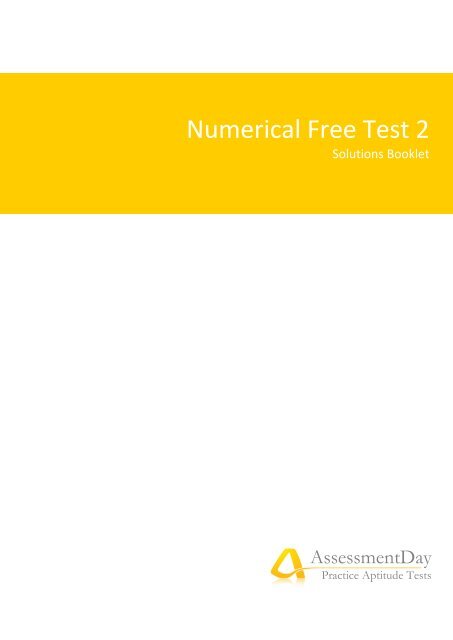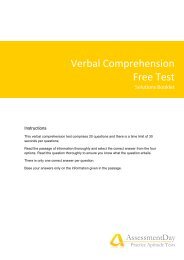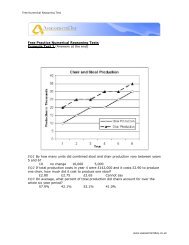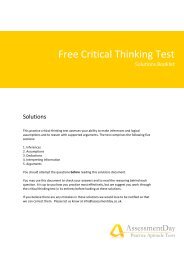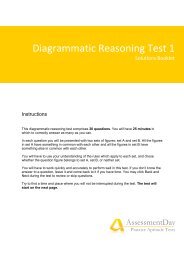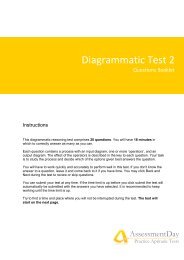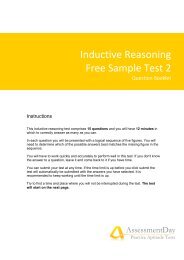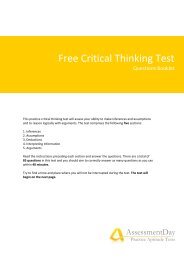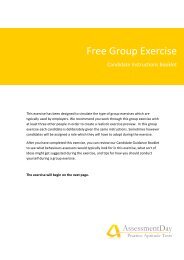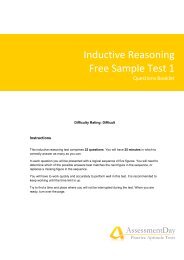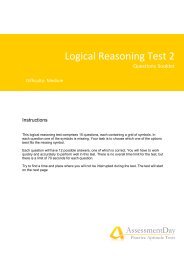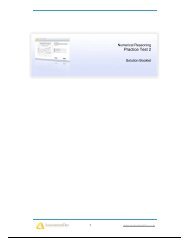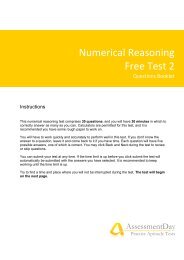Numerical Free Test 2 - Aptitude Test
Numerical Free Test 2 - Aptitude Test
Numerical Free Test 2 - Aptitude Test
Create successful ePaper yourself
Turn your PDF publications into a flip-book with our unique Google optimized e-Paper software.
<strong>Numerical</strong> <strong>Free</strong> <strong>Test</strong> 2Solutions BookletAssessmentDayPractice <strong>Aptitude</strong> <strong>Test</strong>s
Q1Which company has the highest annual profit per employee?(A) A(B) B(C) C(D) DStep 1 - Simply divide the annual profit by the number of employees for each company:Company A = £4,000/employee.Company B = £3,250/employee.Company C = £2,625/employee.Company D = £2,500/employee.Tip - This is a relatively easy question; don’t waste time by looking for anything morecomplicated.Thus the correct answer is (A) AQ2If the profits per employee remain the same, how many extra employeeswould Company B have to recruit to achieve annual profits of £39,000?(A) 6(B) 3(C) 12(D) 4Step 1 - For company B, profit per employee is originally (£26,000 ÷ 8) = £3,250/employee.So £39,000 ÷ £3,250 = 12 employees, which is 4 more than they currently have.Tip - Whilst each question can be done in isolation, it will help here if you can quickly locatethe workings from the previous question.Thus the correct answer is (D) 4Copyright AssessmentDay. Unauthorised copyingor distribution in printed, electronic, or any otherform in whole or in part, is prohibited withoutprior written permission from AssessmentDay.Page 2Document last updated 05-07-2012AssessmentDaywww.assessmentday.co.uk
Q3If every employee of Company D contributes equally, how much would eachemployee have to contribute in order to collectively buy Company A?(A) £1,500(B) £1,700(C) £2,700(D) £2,100Step 1 - We are told that the cost to buy Company A is £18,000. We are also told there are12 employees in Company A. So £18,000 ÷ 12 employees = £1,500 per person.Thus the correct answer is (A) £1,500Copyright AssessmentDay. Unauthorised copyingor distribution in printed, electronic, or any otherform in whole or in part, is prohibited withoutprior written permission from AssessmentDay.Page 3Document last updated 05-07-2012AssessmentDaywww.assessmentday.co.uk
Q4Between 1990 and 2000, what was the increase in energy use for the PCRoom, Meeting Rooms and Office Space combined?(A) 50kWh(B) 184kWh(C) 188kWh(D) Cannot sayStep 1 - The graphs give percentages, with the total shown at the bottom. Don’t waste timeby working out the kWh value for each of the PC Room, the Meeting Rooms and the OfficeSpace. Use the percentages and add up at the end:In 1990: (12% + 12% + 41%) of 17,000kWh = 11,050kWhIn 2000: (21% + 14% + 39%) of 15,000kWh = 11,100kWh.Which is an increase of 50kWh.Thus the correct answer is (A) 50kWhCopyright AssessmentDay. Unauthorised copyingor distribution in printed, electronic, or any otherform in whole or in part, is prohibited withoutprior written permission from AssessmentDay.Page 4Document last updated 05-07-2012AssessmentDaywww.assessmentday.co.uk
Q5If the Building Energy Use today is 6% less than it was in 2000, by whatpercentage is today’s Building Energy Use lower than that of 1990?(A) 82.9%(B) 17.1%(C) 17.8%(D) Cannot sayStep 1 - Total energy usage in 2000 = 15,000kWh, so today’s at 6% less is 15,000 x 0.94 =14,100kWh. This compares with 1990 levels of 17,000kWh.Step 2 - To work out the reduction from 17,000 to 14,100, calculate (14,100 ÷ 17,000) =0.8294, which is a reduction of (1-0.8294 = 0.17059) 17.1%.Thus the correct answer is (B) 17.1%Copyright AssessmentDay. Unauthorised copyingor distribution in printed, electronic, or any otherform in whole or in part, is prohibited withoutprior written permission from AssessmentDay.Page 5Document last updated 05-07-2012AssessmentDaywww.assessmentday.co.uk
Q6 Which space experienced the smallest reduction in kWh used between 1990and 2000?(A) Office Space(B) Print Room(C) Meeting Rooms(D) PC RoomStep 1 - We can rule out the PC Room from the possible answers by inspection since it isapparent its energy use actually increased between 1990 and 2000.Step 2 - So the other three possible answers:Print Room: 2,550 – 1,800 = 750kWh.Office Space: 6,970 – 5,850 = 1,120kWh.Meeting Rooms: 2,040 – 2,100 = Increase of 60kWh (note question asked for smallestreduction).Thus the correct answer is (B) Print RoomCopyright AssessmentDay. Unauthorised copyingor distribution in printed, electronic, or any otherform in whole or in part, is prohibited withoutprior written permission from AssessmentDay.Page 6Document last updated 05-07-2012AssessmentDaywww.assessmentday.co.uk
Q7Approximately what percentage of the people sampled are unemployed?(A) 7%(B) 5%(C) 6%(D) 4%Step 1 - Make sure you add together the male and female figures to arrive at a figure for‘people’.Total number unemployed = 52,000 + 43,000 = 95,000.Step 2 - Total number people sampled = 1,343,000 + 1,031,000 = 2,374,000.Step 3 - So now 97,000 ÷ 2,374,000 = 4%.Thus the correct answer is (D) 4%Copyright AssessmentDay. Unauthorised copyingor distribution in printed, electronic, or any otherform in whole or in part, is prohibited withoutprior written permission from AssessmentDay.Page 7Document last updated 05-07-2012AssessmentDaywww.assessmentday.co.uk
Q8 If it is predicted that the number of females employed in IT will rise by 10%every year, but the number of males stays the same, what percent of ITemployees would be female after a three year period?(A) 54.1%(B) 53.5%(C) 85.0%(D) 45.5%Step 1 - Number of female IT employees to start with is 107,000 from the table.Step 2 - If the number of female employees rises by 10%, that gives 142,417 employees afterthree years (107,000 x 1.10 x 1.10 x 1.10 = 142,417).Step 3 - The number of male IT employees is still 121,000, so the total in IT is now 142,417 +121,000 = 263,417. So 142,417 out of 263,417 IT employees is 54.07%.Tip - With this question, where we are dealing with number of people, you should end up withintegers in the working since it is not possible to have part of a person. If you start to getdecimals, consider whether you have made a mistake.Thus the correct answer is (A) 54.1%Copyright AssessmentDay. Unauthorised copyingor distribution in printed, electronic, or any otherform in whole or in part, is prohibited withoutprior written permission from AssessmentDay.Page 8Document last updated 05-07-2012AssessmentDaywww.assessmentday.co.uk
Q9What was the average accident cost per vehicle on the road in Ribley inNovember?(A) £0.23(B) £0.47(C) £15.40(D) £2.30Step 1 - Hopefully you have noticed that the ‘Vehicles on Road’ figures are in thousands.Total average cost of accidents in Ribley in November = 10 x £1,900 = £19,000. Number ofvehicles on road = 81,000. So £19,000 ÷ 81,000 = £0.2346.Tip - Don’t be fooled into thinking the answer is simply the ‘Average cost per accident’ figuregiven on the right hand side; per vehicle on the road is what the question is after. If it looks asthough all you have to do for a question is read a number from the figure, you have probablymisunderstood.Thus the correct answer is (A) £0.23Copyright AssessmentDay. Unauthorised copyingor distribution in printed, electronic, or any otherform in whole or in part, is prohibited withoutprior written permission from AssessmentDay.Page 9Document last updated 05-07-2012AssessmentDaywww.assessmentday.co.uk
Q10Comparing Wartop with Surren, what was the difference in average accidentcost per vehicle on the road in October?(A) 3.4p(B) 6.4p(C) £64.60(D) £0.70Step 1 - The working is similar to the previous question, but there is a but more work to thisquestion as you have to work it out for two towns. Again, don’t forget that the ‘Vehicles onRoad’ figure is in thousands. The fact that the question asks for ‘average accident cost’means we can answer the question because we are given the ‘Average cost per accident’figure to apply to all accidents. Otherwise we’d have to know the cost of every single accident.Wartop: (£3,200 per accident x 4 accidents) ÷ 89,000 vehicles on road = (12,800) ÷ 89,000 =£0.1438.Surren: (£1,050 per accident x 9 accidents) ÷ 119,000 vehicles on road = (9,450) ÷ 119,000 =£0.0794.Step 2 - Difference = £0.064.Thus the correct answer is (B) 6.4pCopyright AssessmentDay. Unauthorised copyingor distribution in printed, electronic, or any otherform in whole or in part, is prohibited withoutprior written permission from AssessmentDay.Page 10Document last updated 05-07-2012AssessmentDaywww.assessmentday.co.uk
Q11The only towns in the County are Ribley, Wartop and Surren. What was theaverage accident cost per vehicle on the road in September for the County?(A) £0.17(B) £0.32(C) £0.94(D) £20.50Tip - Don’t be fooled into working out the average accident cost per vehicle on road for allthree towns, and then finding the average of these by summing and dividing by three. This isnot the overall average, this would give a distorted average toward the town with the lowestnumber of accidents.Step 1 - We need to first find the total costs of all accidents for all towns: (£1,900 x 6) +(£3,200 x 18) + (£1,050 x 20) = £90,000.Step 2 - Now divide this by the total number of vehicles on the road for all three towns(76,000 + 101,000 + 104,000) = 281,000.Step 3 - So £90,000 ÷ 281,000 = £0.320.Thus the correct answer is (B) £0.32Copyright AssessmentDay. Unauthorised copyingor distribution in printed, electronic, or any otherform in whole or in part, is prohibited withoutprior written permission from AssessmentDay.Page 11Document last updated 05-07-2012AssessmentDaywww.assessmentday.co.uk
Q12 In 1996, total output from all fuels was 200TWh. If output for Nuclear in 2006was twice that for Coal in 1996, what was the output for Nuclear in 2006?(A) 140TWh(B) 400TWh(C) 64TWh(D) 96TWhTip - If you read this quickly, it might be daunting. It needn’t be if you take each step at a time.Step 1 - We are told that the total output from all fuels in 1996 is 200TWh, so we can work outwhat is was for coal in 1996.Coal in 1996 was 35% of 200TWh: 70TWh. So Nuclear in 2006 is twice this: 140TWh.Thus the correct answer is (A) 140TWhCopyright AssessmentDay. Unauthorised copyingor distribution in printed, electronic, or any otherform in whole or in part, is prohibited withoutprior written permission from AssessmentDay.Page 12Document last updated 05-07-2012AssessmentDaywww.assessmentday.co.uk
Q13If between 1996 and 2006, Renewables output doubled to 18TWh,approximately what was the Gas output in 1996?(A) 129TWh(B) 86TWh(C) 120TWh(D) 110TWhTip - Again, work through each step using what we have been told. Bear in mind you neverneed information that was given in the previous question; each question should stand alone.Step 1 - So in 2006 we are told Renewables was 18TWh, which was double what it was in1996: 9TWh.Step 2 - Therefore, if 9TWh is 3% of the total (according to chart), the total in 1996 was300TWh (9TWh ÷ 0.03 = 300TWh). Gas we are told made up 43% in 1996, i.e. 0.43 x300TWh = 129TWh.Thus the correct answer is (A)129TWhCopyright AssessmentDay. Unauthorised copyingor distribution in printed, electronic, or any otherform in whole or in part, is prohibited withoutprior written permission from AssessmentDay.Page 13Document last updated 05-07-2012AssessmentDaywww.assessmentday.co.uk
Q14If total output was 200TWh in 1996 and 320TWh in 2006, what was Gasoutput in 2001?(A) 107TWh(B) 133TWh(C) 120TWh(D) Cannot sayThis is a fairly obvious ‘cannot say’ question. Don’t try to extrapolate between 1996 and 2000since we are not told what the trend was. No data is given, or can be implied, for 2001 in thequestion. Often, it is less obvious that the answer cannot be determined from the availableinformation.Thus the correct answer is (D) Cannot sayCopyright AssessmentDay. Unauthorised copyingor distribution in printed, electronic, or any otherform in whole or in part, is prohibited withoutprior written permission from AssessmentDay.Page 14Document last updated 05-07-2012AssessmentDaywww.assessmentday.co.uk
Q15This year saw a 20% increase in the total number of refunds over last year.Approximately how many refunds were issued this year due to DeliveryDamage?(A) 102(B) 104(C) 124(D) 1040Step 1 - Total refunds last year: 912, so for this year add 20% by multiplying 912 by 1.2 whichcomes to 1094.4.Step 2 - Of these 1094.4 refunds, we are told from the table 9.5% were refunded due todelivery damage. So 0.095 x 1094.4 = 103.97. The fact that the questions asks for an‘approximate’ number of refunds means our decimal place answer for what can be only aninteger is OK (in fact it should encourage us because an integer answer would not ask for an‘approximate’ number in the question.)Thus the correct answer is (B) 104Copyright AssessmentDay. Unauthorised copyingor distribution in printed, electronic, or any otherform in whole or in part, is prohibited withoutprior written permission from AssessmentDay.Page 15Document last updated 05-07-2012AssessmentDaywww.assessmentday.co.uk
Q16The number of refunds last year due to Faulty Hardware was an increase of15% above the year before last. Approximately how many complaints werereceived from Faulty Hardware in the year before last?(A) 186(B) 215(C) 325(D) 343Step 1 - Start with the total for last year: 912.Step 2 - From the table we see that 41% of these were due to Faulty Hardware, so we knowthat last year there were (0.41 x 912 =) 373.92 refunds due to Faulty Hardware.Step 3 - Now, we are told in the passage that this figure is a 15% increase above the yearbefore last. So 373.92 ÷ 1.15 = 325.15 will be the number of refunds for the year before last.Thus the correct answer is (C) 325Copyright AssessmentDay. Unauthorised copyingor distribution in printed, electronic, or any otherform in whole or in part, is prohibited withoutprior written permission from AssessmentDay.Page 16Document last updated 05-07-2012AssessmentDaywww.assessmentday.co.uk
Q17If the total number of refunds this year was 840, by what percentage didFaulty Hardware refunds increase between last year and this year?(A) 7.8%(B) 2.8%(C) 79.1%(D) 11.0%Step 1 - This one is a fairly straight forward application of percentages.Last year = 912 x 41% = 373.9This year = 840 x 48% = 403.2Therefore increase = 403.2 ÷ 373.9 = 1.0784, which is an increase of 7.84%.Thus the correct answer is (A) 7.8%Copyright AssessmentDay. Unauthorised copyingor distribution in printed, electronic, or any otherform in whole or in part, is prohibited withoutprior written permission from AssessmentDay.Page 17Document last updated 05-07-2012AssessmentDaywww.assessmentday.co.uk
Q18What was the approximate value in Pounds Sterling of 150 Canadian Dollarsin 1995?(A) £55(B) £75(C) £130(D) £300Step 1 - The table shows us that 1 Canadian Dollar is worth 0.5 Pounds Sterling. So 150CAD x 0.5 = £75.Thus the correct answer is (B) £75Q19 Approximately how many Euros was 85 Russian Rubles worth in May 1995?(A) Є2.46(B) Є2,933(C) Є1,900(D) Cannot sayYou have to convert both Euros and Rubles to a common reference (we’ll use Pounds). Sofor 85 Rubles; 85 x 0.020 = £1.7. We are told one Euro is worth £0.69, so £1.7 must be worth€2.464.Copyright AssessmentDay. Unauthorised copyingor distribution in printed, electronic, or any otherform in whole or in part, is prohibited withoutprior written permission from AssessmentDay.Page 18Document last updated 05-07-2012AssessmentDaywww.assessmentday.co.uk
Q20How many more Canadian Dollars would 100 UK Pounds Sterling buy thanwould 120 US Dollars in May 1995?(A) CAD$35(B) CAD$54(C) CAD$60(D) CAD$62Step 1 - 100 Pounds = 200 CAD (100 ÷ 0.5).Step 2 - 120 US Dollars = 137.93 CAD (120 ÷ 0.87).Step 3 - So the difference is 200– 137.93 = 62.07 CAD.Thus the correct answer is (D) CAD$62Copyright AssessmentDay. Unauthorised copyingor distribution in printed, electronic, or any otherform in whole or in part, is prohibited withoutprior written permission from AssessmentDay.Page 19Document last updated 05-07-2012AssessmentDaywww.assessmentday.co.uk
Q21 How many cars under 2,000kg were there in France in 1995?(A) 918,000(B) 918(C) 408,000(D) 737,000Step 1 - Simply add up the number of cars in each bracket up to 1,999kg. There’s also a littlething to look out for which is that these figures are all in thousands. So 510 + 346 + 56 + 6(thousand) = 918,000.Thus the correct answer is (A) 918,000Copyright AssessmentDay. Unauthorised copyingor distribution in printed, electronic, or any otherform in whole or in part, is prohibited withoutprior written permission from AssessmentDay.Page 20Document last updated 05-07-2012AssessmentDaywww.assessmentday.co.uk
Q22 What was the combined mass of all the cars in the UK in 2000?(A) 211,000kg(B) 858,500kg(C) 1,426,500kg(D) Cannot SayYou might be tempted to do something like multiply the number of cars in each range by theiraverage weight, or something similar. Don’t; read the question carefully. Because the data isgrouped, we don’t know how many cars are at the bottom end of the group, and how manyare towards the top. It is impossible to say from the data given.Thus the correct answer is (D) Cannot SayQ23In the UK, what was the percentage increase in the total number of carsbetween 1995 and 2000?(A) 15.0%(B) 16.6%(C) 32.1%(D) 58.0%You have to find the sum of the number of cars in 1995, do the same for 2000, and work outthe percentage difference between the two.Step 1 - In 1995: 4 + 21 + 292 + 420 + 71 = 808 (thousand)Step 2 - In 2000: 9 + 32 + 341 + 495 + 65 = 942 (thousand)Step 3 - So the percentage increase was 942 ÷ 808 = 1.166 = 16.6%.Thus the correct answer is (B) 16.6%Copyright AssessmentDay. Unauthorised copyingor distribution in printed, electronic, or any otherform in whole or in part, is prohibited withoutprior written permission from AssessmentDay.Page 21Document last updated 05-07-2012AssessmentDaywww.assessmentday.co.uk
Q24How many live births occurred in 1985 in Greece and Australia combined?(A) 21,200(B) 748,200(C) 1,051,000(D) Cannot sayNote live births are given per 1,000 population.Step 1 - So considering each country we have:Greece: 28.5 (million) x 13.2 (per 1000). The best way to rationalise the units is to say this isequivalent to 28,500 x 13.2 which = 376,200.Step 2 - And the same with Australia: 46.5 (million) x 8.0 (per 1000) = 372,000.Step 3 - Add these together and the total is 748,200.Thus the correct answer is (B) 748,200Copyright AssessmentDay. Unauthorised copyingor distribution in printed, electronic, or any otherform in whole or in part, is prohibited withoutprior written permission from AssessmentDay.Page 22Document last updated 05-07-2012AssessmentDaywww.assessmentday.co.uk
Q25Which country had the highest number of people aged under 15 at the start of1985?(A) UK(B) France(C) Australia(D) GermanyImmediately from the possible answers we can neglect Greece in our working.Step 1 - But we have to work out the number of people under 15 for the other countries,although we don’t need to bother with the units since the question asks only for the largest inmagnitude.UK: 56.6 x 19% = 10.754France: 55.2 x 21% = 11.592Australia: 46.5 x 17% = 7.905Germany: 61.0 x 15% = 9.15Thus the correct answer is (B) FranceCopyright AssessmentDay. Unauthorised copyingor distribution in printed, electronic, or any otherform in whole or in part, is prohibited withoutprior written permission from AssessmentDay.Page 23Document last updated 05-07-2012AssessmentDaywww.assessmentday.co.uk
Q26 What was the net effect on the UK population in 1985?(A) Increase of 84,900(B) Increase of 85,170(C) Increase of 542,810(D) Decrease of 61,400We have to consider the births and deaths and find the net effect.Step 1 - Births: 13.3 (per 1000) x 56.6 (million) = 752,780.Step 2 - Deaths: 11.8 (per 1000) x 56.6 (million) = 667,880.Step 3 - So the net increase is 84,900.Thus the correct answer is (A) 84,900Q27Approximately what percentage of the German population were aged 60 orover at the end of 1985?(A) 20%(B) 21%(C) 16%(D) Cannot SayThe end column giving percent over 60 is for the start of the year only. By the end of the year,this will certainly have changed but we are not told what the figure is.Thus the correct answer is (D) Cannot SayCopyright AssessmentDay. Unauthorised copyingor distribution in printed, electronic, or any otherform in whole or in part, is prohibited withoutprior written permission from AssessmentDay.Page 24Document last updated 05-07-2012AssessmentDaywww.assessmentday.co.uk
Q28For the four shops combined, which of the months shown saw the largestdecrease in number of PC sales compared to the previous month?(A) Feb(B) Mar(C) Apr(D) Cannot sayStep 1 - Sometimes it is possible to rule out some of the possible answers just by looking atthe figure, but for this question that is quite difficult. We have to sum for every month:Jan: 8 + 20 + 5 + 10 = 43Feb: 10 + 20 + 4 + 14 = 48Mar: 13 + 18 + 6 + 18 = 55Apr: 10 + 16 + 8 + 19 = 53April was the only month where sales dropped from levels of the previous month.Note the question said for “the months shown”. This is important because otherwise wewouldn’t be able to tell without being given sales figures for May – December.Thus the correct answer is (C) AprilCopyright AssessmentDay. Unauthorised copyingor distribution in printed, electronic, or any otherform in whole or in part, is prohibited withoutprior written permission from AssessmentDay.Page 25Document last updated 05-07-2012AssessmentDaywww.assessmentday.co.uk
Q29Approximately what percentage of Regal PC’s sales were made in April?(A) 21%(B) 22%(C) 24%(D) 28%This is a fairly straightforward percentage question.Step 1 - Total PC sales for Regal in the data given = 8 + 10 + 13 + 10 = 41.Sales in April = 10.Step 2 - So 10 ÷ 41 = 24.4%.Thus the correct answer is (C) 24Copyright AssessmentDay. Unauthorised copyingor distribution in printed, electronic, or any otherform in whole or in part, is prohibited withoutprior written permission from AssessmentDay.Page 26Document last updated 05-07-2012AssessmentDaywww.assessmentday.co.uk
Q30If the average profit made on each PC sold by Quick PC was £62, what wasthe total profit over the four months for Quick PC?(A) £3,144(B) £3,782(C) £3,857(D) Cannot sayStep 1 - Total sales by Quick PC over the four months = 10 + 14 + 18 + 19 = 61.Step 2 - So 61 x £62 = £3,782.Thus the correct answer is (B) £3,782-- End of <strong>Test</strong> --For more numerical reasoning tests visit AssessmentDay.co.ukCopyright AssessmentDay. Unauthorised copyingor distribution in printed, electronic, or any otherform in whole or in part, is prohibited withoutprior written permission from AssessmentDay.Page 27Document last updated 05-07-2012AssessmentDaywww.assessmentday.co.uk


